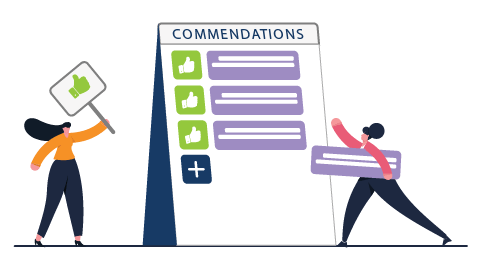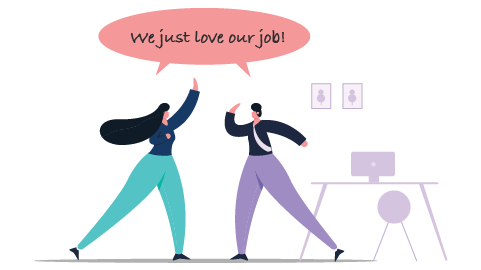How To Become An Employer Of Choice?
Are you an employer of choice? But what exactly does being an "employer of choice" mean? Is it about being classified as being the best organization to work for, or is it more?
By definition, what makes an organization an employer of choice is its potential to recruit and keep the top talents. It calls for a favorable organizational culture, leadership styles, and employee engagement. There are many dimensions that HR needs to understand to become an employer of choice.
How To Be An Employer Of Choice?
Glassdoor says that salary and benefits top the chart of why candidates join a company (48%). But the results show that candidates are searching for more than a good salary.
Corporate culture is essential to 37% of respondents. The employer brand follows it at 36 percent.
The interview experience of applicants is also regarded. How managers handle interviews is a big influencer at 33%. Again, senior leadership skills hit 25% of the respondents.
Summing it up all, here are some factors that can help you to be an employer of choice
8 Factors That Make An Organization An Employer Of Choice
1. Map out your company's employee engagement journey

Journey mapping helps organizations to consider the moments that matter most to employees. Employee surveys should measure engagement at critical points in the path. It should be carried out based on where the employee is on their journey, as opposed to the yearly company-wide surveys.
2. Define what will make your organization their employer of choice

Take a closer look at what people see, think, and talk about your organization as a workplace. All those insights will help you build a robust Talent Identity Infrastructure. Furthermore, socializing your brand will promote your company culture and Employer Value Proposition. It will also highlight how you manage talent.
Encourage your employees to share their views on what makes you their employer of choice. A positive online word of mouth from a current employee can create the right buzz. It's more trustworthy and valuable for you and your prospective employees.
3. Provide the right tools

Getting the right tools at the workplace should be a standard now, but many organizations struggle to do so. The benefits of an employer providing the right tools to their employees are-
- Efficient tools bring safety to the workplace.
- Tools make the work easier and comfortable for the workers.
- Top college graduates always look if the workplace is technologically adept. Thus, it helps to attract and retain talents.
- If you have the right tools, your employee training gets easier.
- The right tools help in a smoother transition from newbie to core team members. In the long term, it keeps happy and satisfied.
When employees are not given the correct tools, they are forced to rely on whatever they can access. It can result in inefficiency and slow progress, that organizations like to avoid.
Ensure you stay aware of the changing demands and provide them the most needed tools. Employees may not feel comfortable telling you that they need more or better tools. So it's a smart thought to check with them yourself.
Related article- 17 Must-Have Tools for Remote Workers
4. Consider benchmarked rewards and recognition
Employers should plan their mix of rewards and recognitions. Your offers should meet the needs of the employees. It will be better if you can display it as an interactive collection of choices.
It is essential to understand the challenges of different generations in the workplace. Generally, we find Baby Boomers focus on base pay and retirement plans. Whereas, Gen Xers needs stability and career growth. Again, millennials look for a transparent work environment, feedback, and clarity in expectations.
Thus, the system of rewards and recognition will change according to the needs and values of both the employees and the organization. It needs to know what the employees value and listen to their feedback. Creating a benchmark for rewards and recognition can be a challenging task. But, it will be a pleasure to have employees involved and dedicated.
5. Make your employee confident with job security

The minute you do any layoffs, you might as well lay off the whole joint because everybody forgets about the customer and worries about their own job security. - Steve Wynn
Employees wish to stay with organizations where they know they will have a job if they work hard. Employees with job security are more willing to take risks for their organization. So, if you're a manager (or an employer), you must make sure that employees feel safe and secured in their position. If they have to worry about their future in the organization, it will be hard for them to focus and do their best work.
6. Create a culture of choice

Emphasize the culture of your organization and your hiring strategies. Hire not for culture-fit; lift the bar, and go for culture-adding.
Find out what is essential for your employees and put yourself accordingly. Personal experience and positive relationships are excellent boosters for your current employees. Besides, it will build awareness, consideration, and preference among prospective employees.
Related article- 9 Tips To Build a Healthy Work Relationship With Employees
7. Focus on work-life balance
You will never feel truly satisfied by work until you are satisfied by life.- Heather Schuck
A balanced work-life reduces the burden on workers. It allows them to face life demands while working, without interruption. That is why work-life balance is an increasing demand among employees. Thus, it's vital to have initiatives like flexible work schedules and leave policies.
8. Provide opportunities for upskilling and reskilling

"Talent is looking for employers who offer career development through on-the-job coaching. It helps to evolve their career in different ways. Be it applying a business analyst’s skills to becoming enterprise architect," says Bhushan Sethi, Joint Global Leader, People & Organization, PwC.
Today’s employees look for a sharp growth curve. The best candidates seek organizations offering upskilling and reskilling advantages. Thus employers need to rethink on-the-job learning and development. Its focus should be on continuous and multigenerational upskilling and reskilling.

















